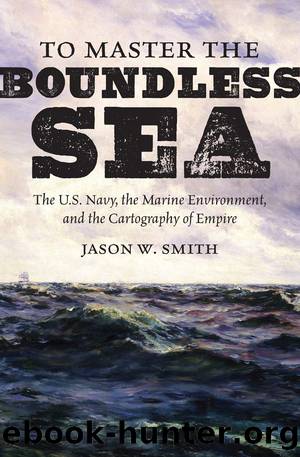To Master the Boundless Sea by Smith Jason W.;

Author:Smith, Jason W.;
Language: eng
Format: epub
Publisher: University of North Carolina Press
Detail of Chart of Ewa or Pearl River, United States Exploring Expedition, 1840, showing depth soundings and lines of triangulation in the channel, a village, and a meeting point, among other features indicative of broader commercial and cultural interests. Courtesy of the Library of Congress, Geography and Map Division.
Detail of Pearl Harbor and Lochs, Hydrographic Office No. 1141, 1893, showing depth soundings in the channel and the process of transformation ashore, including âproximate line of wall,â as Hawaii, Pearl Harbor in particular, gradually came to be a place of strategic interest for the navy and the United States. Courtesy of the Library of Congress, Geography and Map Division.
The hydrographic chart itself reflected and perpetuated these changes. When Lieutenant Charles Wilkes and the U.S. Exploring Expedition surveyed the mouth of the Pearl River on the island of Oahu in 1840, for example, he wrote in the expeditionâs Narrative that âafter passing this coral bar ⦠the depth of water becomes ample for large ships, and the basin is sufficiently extensive to accommodate any number of vessels. If water upon the bar should be deepened,â he concluded, âit would afford the best and most capacious harbor in the Pacific.â Wilkes admitted that for the moment, though, the nearby port of Honolulu was âsufficient for all the present wants ⦠and the trade that frequents them.â There was âas yet ⦠no necessity for such an operation,â by which he meant deepening the shallow channel that led to the magnificent and nearly land-locked anchorage of Pearl Harbor. The expeditionâs chart, like its survey of the Fiji Islands, represented a mix of commercial and indigenous meanings. There was the bar itself and the soundings of Pearl Harborâs narrow channel. The Americans, however, had not extended their survey farther into the harbor. The bar blocked any passage and, as Wilkes said, Honolulu was sufficient for commercial purposes. The expeditionâs chart also marked a Meeting Point, a salt works, numerous villages, a block house, and oyster beds, evidence of commercial understandings that were so important to the early American presence in these islands, and also of the Anglo-American encounter with the indigenous Hawaiians.44
When the navy returned to Pearl Harbor again in 1887, the new chartâH.O. 1141âreflected the extraordinary changes that had occurred in the intervening half century. That year, King David KalÄkauaâthe same monarch whose claim to the Hawaiian throne Belknap and the Tuscarora had upheld in 1874âhad signed a Treaty of Reciprocity with the United States. Among other things, it granted the Americans âexclusive right to enter the harbor of the Pearl River and establish a coaling and repair station for the use of vessels of the United States. And to that end,â the agreement continued, âthe U.S. may improve the entrance to said harbor and do all the other things needful to the purpose aforesaid.â The steam sloop Vandalia began its survey soon after. âI had been interested in Pearl Harbor and the facilities which it possesses for the establishment of a secure and commodious coaling station,â wrote Rear Admiral John G.
Download
This site does not store any files on its server. We only index and link to content provided by other sites. Please contact the content providers to delete copyright contents if any and email us, we'll remove relevant links or contents immediately.
| Automotive | Engineering |
| Transportation |
Urban Outlaw by Magnus Walker(2950)
Never by Ken Follett(2884)
OPNsense Beginner to Professional by Julio Cesar Bueno de Camargo(2805)
Sapiens and Homo Deus by Yuval Noah Harari(2416)
Machine Learning at Scale with H2O by Gregory Keys | David Whiting(2293)
A Short History of Nearly Everything by Bryson Bill(2135)
Will by Will Smith(2043)
Hooked: A Dark, Contemporary Romance (Never After Series) by Emily McIntire(1964)
Borders by unknow(1786)
Rationality by Steven Pinker(1765)
Holy Bible (NIV) by Zondervan(1716)
Freedom by Sonny Barger(1485)
The One Percenter Encyclopedia by Bill Hayes(1463)
Five Ways to Fall by K.A. Tucker(1397)
Girls Auto Clinic Glove Box Guide by Patrice Banks(1363)
Far and Near by Neil Peart(1357)
The Becoming by Nora Roberts(1331)
Cuba's Car Culture by Tom Cotter(1325)
A Short History of War by Jeremy Black(1300)
